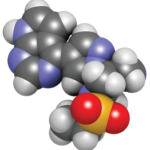 An observational study of the relative risk for venous thromboembolism events from two immunotherapeutic modalities used to treat rheumatoid arthritis (RA) finds a numerical—but not statistically significant—increase of venous thromboembolism from tofacitinib when compared with tumor necrosis factor (TNF) inhibitors.1 In 2012, tofacitinib became the first Janus kinase inhibitor (jakinib) approved by the U.S. Food & Drug Administration (FDA) to treat RA. But research into high-dose baricitinib therapy for RA and a post-marketing study of tofacitinib and TNF inhibitors to assess cardiovascular risk have raised questions about the association of jakinibs with venous thromboembolism.2-4
An observational study of the relative risk for venous thromboembolism events from two immunotherapeutic modalities used to treat rheumatoid arthritis (RA) finds a numerical—but not statistically significant—increase of venous thromboembolism from tofacitinib when compared with tumor necrosis factor (TNF) inhibitors.1 In 2012, tofacitinib became the first Janus kinase inhibitor (jakinib) approved by the U.S. Food & Drug Administration (FDA) to treat RA. But research into high-dose baricitinib therapy for RA and a post-marketing study of tofacitinib and TNF inhibitors to assess cardiovascular risk have raised questions about the association of jakinibs with venous thromboembolism.2-4
Janus kinases are believed to play an important role in inflammatory processes by signaling more than 50 cytokines and growth factors. Small-molecule jakinibs, starting with tofacitinib and then baricitinib, approved by the FDA for RA in 2018, have expanded treatment options. They offer a novel treatment modality with the potential to become as important as TNF inhibitors in treating RA, says Rishi J. Desai, MS, PhD, assistant professor of medicine at Harvard Medical School, Boston, and an associate epidemiologist in the Division of Pharmacoepidemiology and Pharmacoeconomics at Brigham and Women’s Hospital, Boston. He is the lead author of the new study.
Tofacitinib is a targeted, synthetic, disease-modifying anti-rheumatic drug (DMARD) that inhibits components of the intracellular inflammatory signaling cascade. Its oral administration offers obvious advantages for ease of use, especially because treatment may be needed for a patient’s lifetime. An important concern raised with jakinibs is the risk for venous thromboembolism, even though that happens fairly infrequently, Dr. Desai says.
Tofacitinib has also been studied to treat Crohn’s disease, ulcerative colitis and alopecia areata. Other promising jakinibs under investigation for RA and other autoimmune diseases include filgotinib, which is under investigation for psoriatic arthritis and RA; upadacitinib, which is FDA-approved for RA; abrocitinib, which targets JAK 1; and Pfizer’s JAK 3 inhibitor PF-06651600.
Is Venous Thromboembolism a Class Effect?
“We were curious: Was the venous thromboembolism risk a class effect with JAK inhibitors? We decided to look to population-based studies to get at this question,” Dr. Desai tells The Rheumatologist.
The researchers drew on two, large-population, data sources commonly used in the study of RA, Truven Health Analytics’ proprietary Market Scan Database for the years 2012–16 and the Medicare Parts A, B and D database for the years 2012–15. Researchers performed separate analyses of each database and then a combined analysis.
Individuals with RA aged 18 years and older in the two databases who filled a new prescription for either tofacitinib or a TNF inhibitor (i.e., adalimumab, certolizumab, etanercept, golimumab or infliximab) during the study period were eligible for inclusion in the observational cohort, but only if they had not received prior treatments with these drugs or biologic DMARDs. Cancer patients or those with a prior venous thromboembolism event were excluded.
Researchers identified a total of 457,171 patients in the two databases who received one of these treatments, and 51,160 of them met all inclusion criteria. Those who were starting treatment with tofacitinib numbered 2,905.
Patients were tracked until treatment discontinuation, switch or insurance disenrollment. Venous thromboembolism was identified based on in-patient claims for pulmonary embolism or deep vein thrombosis. Crude incidence rates of venous thromboembolism in the Truven database were 0.60 per 100 person-years for tofacitinib and 0.34 per 100 person-years in patients receiving TNF inhibitors. These incidence rates were slightly higher in the Medicare database, 1.12 per 100 person-years and 0.92 per 100 person-years, respectively. The authors note that these venous thromboembolism rates are quite low.
“We were very conservative about making causal statements, because this was just an observational, cohort study. The possibility of residual confounding remains a limitation of all database studies,” Dr. Desai says.
“Our understanding of the safety profile of JAK inhibitors is evolving,” he adds. “But this study should provide some reassurance to physicians that the risk of venous thromboembolism in RA [patients] may not be very different for these different categories of treatment. Based on this study, we can rule out a large increase in venous thromboembolism risk for treatment with tofacitinib. It also shows that the overall risk of venous thromboembolism is less than one per 100 person-years. But it’s also important to acknowledge that this is only one potential adverse event in the risk-benefit profile.”
How to Interpret the Data
Mark Genovese, MD, professor of medicine and clinical chief of the Division of Immunology and Rheumatology, Stanford University, California, says rheumatologists have lacked necessary context in which to interpret reported data about venous thromboembolism risk in RA treatment.
“We haven’t fully understood how often venous thromboembolism occurs in RA patients or in the general population, and the potential role for any of these treatments in venous thromboembolism. Work being done, including Dr. Desai’s analysis, is very important in helping to put the problem in more specific relief by asking could these treatments cause more frequent venous thromboembolism events?” he says.
Dr. Genovese expressed frustration with potential overreaction to venous thromboembolism data in a presentation at the 2018 Rheumatology Winter Clinical Symposium in Hawaii.5 Previous research from 2013 had begun to create the needed context for interpreting venous thromboembolism risk data by finding that venous thromboembolism was higher in RA than non-RA patients.6 Since then, additional research has helped broaden this context, he says.
TNF inhibitors have become the standard of care in RA, Dr. Genovese says. “It’s important that we know the potential side effects and relative risks and benefits. Certainly, we are seeing these events happen. The field is evolving and our knowledge is growing, along with our opportunities to be better informed about them.”
Larry Beresford is a medical journalist in Oakland, Calif.
References
- Desai RJ, Pawar A, Weinblatt ME, et al. Comparative risk of venous thromboembolism in rheumatoid arthritis patients receiving tofacitinib versus those receiving tumor necrosis factor inhibitors: An observational cohort study. Arthritis Rheumatol. 2019 June; 7(6):892–900.
- U.S. Food & Drug Administration. FDA briefing document: Arthritis Advisory Committee Meeting: NDA 207924 baricitinib janus kinase (JAK) inhibitor for RA. 2018 Apr 23.
- Weinblatt ME, Taylor PC, Burmester GD, et al. Cardiovascular safety during treatment with baricitinib in rheumatoid arthritis [abstract: 2352]. Arthritis Rheumatol. 2017 Oct; 69(Suppl 10).
- Pfizer Inc. News release: Pfizer announces modification to ongoing tofacitinib FDA post-marketing requirement study in patients with rheumatoid arthritis. 2019 Feb 19.
- Jancin B. JAK inhibitors for RA: Is VTE risk overblown? Anticoagulation Hub. 2018 Feb 15.
- Kim SC, Schneeweiss S, Liu J, et al. Risk of venous thromboembolism in patients with rheumatoid arthritis. Arthritis Care Res (Hoboken). 2013 Oct;65(10):1600–1607.





